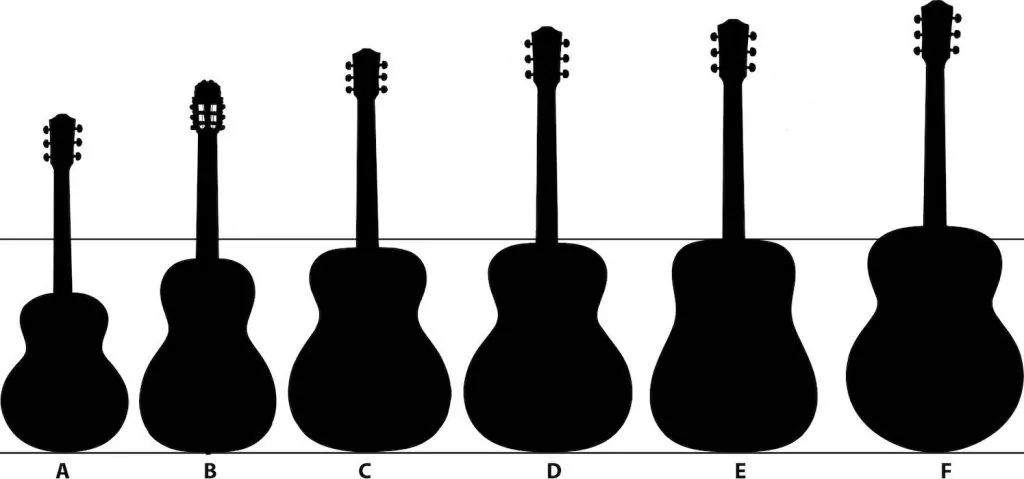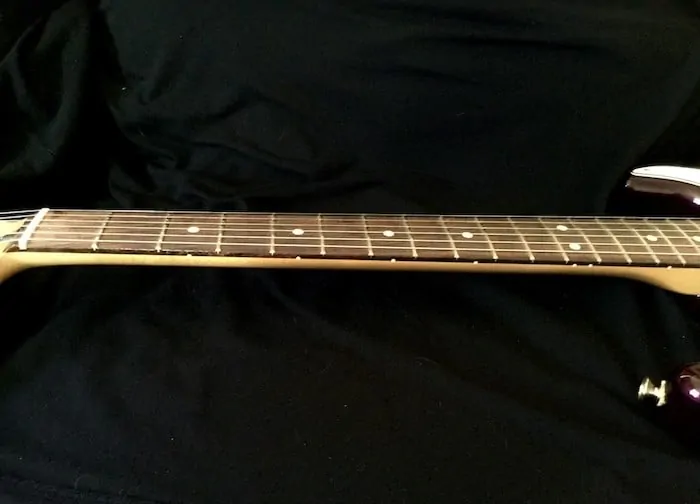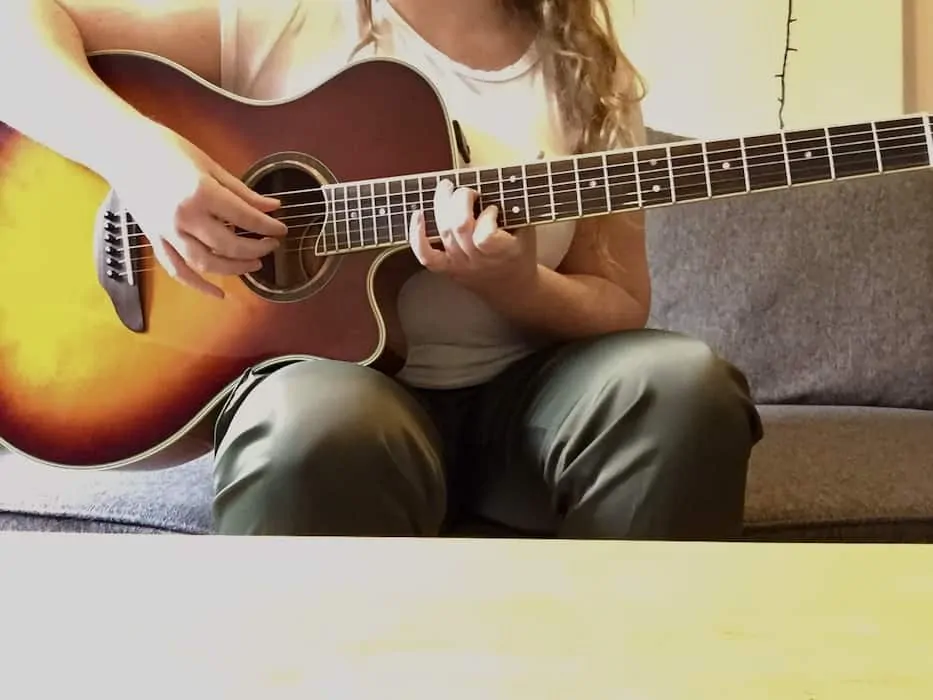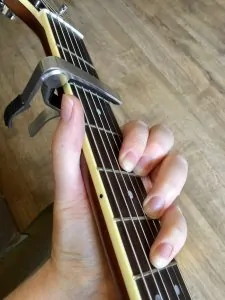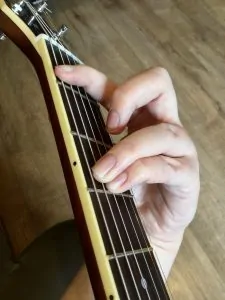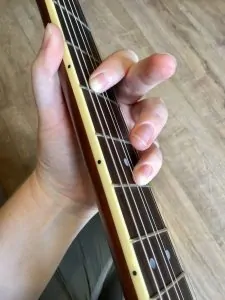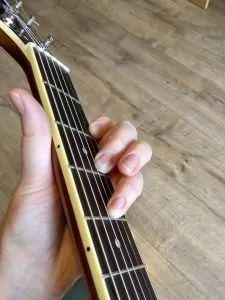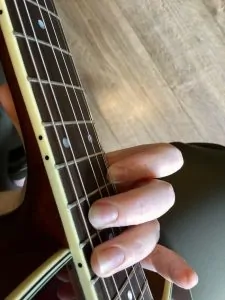Ever feel like your hands are too small for playing guitar? I feel you. As an average size woman, my hands are a far cry from the giant paws of Jimi Hendrix, George Harrison and Stevie Ray Vaughan.
But with a few minor adjustments, I’ve managed to keep up with my big-handed counterparts. It’s all about knowing the right way to choose a guitar, warm up your fingers, tune your strings, fret chords and play crazy solos.
Once you find the right gear and playing techniques, you’ll be ready to shred with the best of them – no matter what size your hands are!
Contents
Choosing the Right Guitar
When you first start playing, it’s tempting to go the classic route and buy a bulky dreadnought acoustic. The problem is most dreadnoughts aren’t designed for small hands. You might find yourself struggling when playing even the most basic chords.
These are the six most common acoustic shapes/sizes: 3/4 size (A), Parlor (B), Grand Concert (C), Auditorium (D), Dreadnought (E) and Jumbo (F). Travel guitars (not pictured) have small, thin rectangular bodies, but roughly the same size neck as dreadnoughts (“Body Shape Guitars” by Mistermoab / CC BY-SA 3.0).
After getting fed up with a hand-me down dreadnought, I decided to switch to a solid body electric guitar. To my surprise, my playing improved almost overnight. I could quickly and easily switch between open chords and finally fret those pesky barre chords.
Does this mean that you shouldn’t play acoustic? Not necessarily. There’s lots of excellent acoustic and electric models for small hands. The trick is knowing what to look for.
Overall size
Most guitars you’ll find at your local music store are probably full size. But many companies also make 3/4 size guitars. They have short necks and small bodies compared to your standard size axe, averaging about 36 x 13 inches instead of 39 x 15 inches.
While this small size may be a plus, 3/4 size guitars tend to be quieter and more treble heavy. Also, there aren’t as many models to choose from, especially for electric. Still, you can find some high quality options, like the Little Martin (Ed Sheeran’s guitar of choice), Baby Taylor, Yamaha FG Jr and Epiphone Les Paul Express.
If you’re an acoustic player, you may want to invest in a travel, parlor, grand concert or auditorium guitar. They all lie on the spectrum between small, bright-sounding 3/4 guitars and big, rich-sounding dreadnoughts and jumbos. However, some of these smaller models, especially parlor guitars, are notoriously difficult to find at music stores.
Luckily, buying a small guitar isn’t the only option. There are lots of full size acoustics and electrics you can play with small hands. It all depends on the shape of the body and neck, and the spacing on the fretboard.
Neck/Fretboard
Generally speaking, the thinner the neck of the guitar, the easier it is to play. That’s why it’s important as a player with small hands to choose your neck shape carefully.
C-shapes are your best choice. They should fit easily in the palm of your hand, allowing you to curl your fingers up and over the fretboard. Many new Fender guitars also come with a modern C-shape. These are slightly flattened, thinner versions of the traditional C, designed for easy playing on your 1st, 2nd and 3rd strings.
Bulky U-shapes and D-shapes should be avoided, as they’re designed for large hands.
This Fender Mexican Standard Stratocaster has a comfortable modern C neck and a 25.5” that provides a bit of stretch for small hands – but nothing too over the top.
Another aspect to consider is scale length. This is the distance from the nut to the bridge. A shorter scale guitar has less space between frets, making it easier to stretch with small fingers.
For electrics, Fender Mustangs and Jaguars have the shortest scale length at 24 inches. Gibson Les Pauls and SGs average 24.75. Fender Stratocasters and Telecasters are much longer at 25.5.
Other electrics and acoustics vary in scale, so it’s best to check the specs before you buy.
Body
One of the easiest ways to play with small hands is to hold your guitar as close to your body as possible. This will help you stretch your fingers over the thickest necks and across the longest scale lengths.
Solid body electrics are the easiest to hold, especially when they include stomach and arm contours for extra comfort. Thin body acoustics are a little bulkier, but can also work wonders for small hands.
Thin body, cutaway acoustics and solid, double-cutaway, contour-body electrics are fantastic options for guitar players with small hands.
For easy access to the 13th fret and beyond, consider buying a guitar with a single- or double-cutaway. Your fingers will thank you when you’re soloing.
Strings
No matter what kind of guitar you end up playing, it’s important to choose strings that feel comfortable and sound great.
Lighter gauge strings are your best bet for small hands. You won’t have to press as hard, making it easier to stretch your fingers across the fretboard while you’re playing.
Electric strings tend to be lighter on the fingers than acoustic steel strings, especially for bends and vibrato. Although they sound brighter than medium or heavy strings, light and extra light acoustic strings can also produce a strong sound.
If you’re learning classical guitar, this shouldn’t be a problem. Nylon strings are much more fingertip friendly.
String gauges are highly subjective, so it’s better to try out a few different gauges and brands before settling on one. To minimize finger pain, I prefer playing with extra light acoustic strings and light electric strings.
Training Your Fingers
Once you’ve chosen your guitar, the next step is to properly stretch your fingers before you start playing. Doing this regularly will help you build dexterity, covering more frets and strings in a single movement – even on bigger guitars.
<iframe width=”560″ height=”315″ src=”https://www.youtube.com/embed/TSrfB7JIzxY” frameborder=”0″ allow=”accelerometer; autoplay; clipboard-write; encrypted-media; gyroscope; picture-in-picture” allowfullscreen></iframe>
This video details some classical-inspired hand stretches that work just as well for steel-string acoustic and electric players.
Another great idea is to start each practice session with warm-up exercises that use your index, middle finger, ring finger and pinky in steady, rhythmic succession going up and down your strings and/or fretboard. After a few weeks, you’ll be amazed at how much easier you can fret your chords.
<iframe width=”560″ height=”315″ src=”https://www.youtube.com/embed/_Zm_ho26O2U” frameborder=”0″ allow=”accelerometer; autoplay; clipboard-write; encrypted-media; gyroscope; picture-in-picture” allowfullscreen></iframe>
Exercises like this are a great way to warm up your left hand and strengthen your fingers.
For extra practice away from your guitar, you can also invest in a hand exerciser. These pocket-sized tools are designed to improve your dexterity and build calluses quickly. Think of it as a sort of fidget spinner that can help you play better!
Changing Your Tuning
While you’re waiting for your strengthening exercises to kick in (and even after), it’s not a bad idea to experiment with some alternate tunings. You’ll not only give your fingers a rest from some of the trickier chords in standard tuning. You can also explore a wider variety of songs.
Drop D
Having trouble reaching the bottom frets on your E-string power chords? Why not try Drop D tuning? Simply downtune your 6th string one whole step from an E to a D. Now, instead of stretching your index finger up two frets on your sixth string, you can rest it comfortably on the same fret as your fifth and fourth strings.
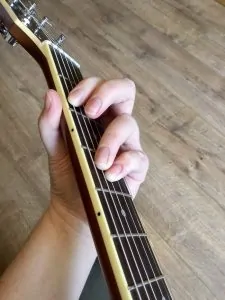
F# power chord in standard tuning (left) vs. Drop D tuning (right).
To make it easier when switching between chords, I like to barre all three strings. Or, you can fret each string individually, like an A-shaped chord.
Luckily, Drop D is already a common in many rock, alternative and metal songs. You can also adapt it to any power-chord heavy song in standard tuning.
Capo
You’ve probably noticed that your neck gets thinner as you travel toward the bridge. If you’re having trouble playing your open chords by the nut, you can always downtune your guitar and use a capo. This way, you can play the same sounding chords higher up the neck.
For every half-step that you downtune your strings, move you capo up the same number of frets. For example, you’d place it on the first fret for downtuning one half step, second fret for downtuning one whole step, etc. Because capos put strain on your neck, I wouldn’t recommend placing it any further than the 5th fret.
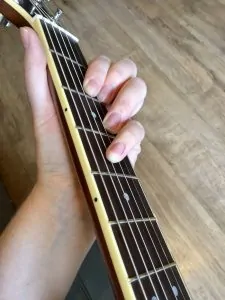
D/F# is a tricky chord to fret with small hands. But look how much easier I can fret it with a capo.
Luckily, capos are already a staple in many acoustic rock, folk and country songs. But it may be trickier to play lead guitar in songs that don’t normally use a capo. After all, you’ll need to move every individual note further down the fretboard.
Still, it’s a solid way to make your rhythm guitar playing even easier.
Altering Your Chords
Whether you’re in standard or alternate tuning, you may come across some chords that your small hands can’t seem to manage. But don’t give up yet! With a few minor adjustments, you’ll find them much easier to fret.
Bring your thumb back
As you can tell by the photos, I tend to bring my thumb over the neck of my guitar. For me, it’s the most comfortable playing position. But when I really need that extra stretch, I place my thumb under the neck, bringing it back toward my palm.
This makes finger-killing chords a lot less…finger killing.
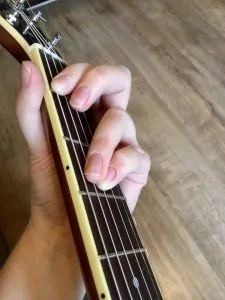
When I bring my thumb backward (right) instead of forward (left), I can stretch my fingers even closer to the bottom fret in a power chord.
It’s up to you where you decide to put your thumb. You might find it just as comfortable to play with your thumb back permanently. Or it might be easier to just bring it back when you need it. Give both a try and see which one works for you.
Use your pinky
When you first start playing guitar, it’s tempting to forget about your pinky and just focus on your other three fingers. But having a strong pinky is a lifesaver for small hands – especially when you need to stretch three or four frets up from your index finger.
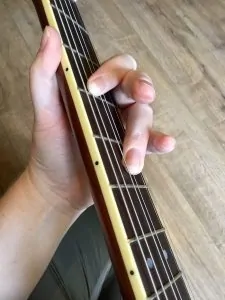
Playing E- and A-string octaves can be tricky with small hands. But you can always substitute your pinky in place of your ring finger.
Playing with your pinky may not work for certain extended chords (especially diminished) or for incorporating bends and vibrato. Still, it’s a helpful adjustment to make until your ring finger can stretch farther on its own.
Substitute barre chords
Barre chords are challenging for beginners of any hand size. But if you have small hands, you might even struggle at an intermediate/advanced level to make a full barre.
Don’t worry. You can always ditch the barre, fretting only the 3rd-6th strings for your E-shaped chords and the 1st-4th strings for your A-shaped chords. Or, you could sacrifice the 3rd by playing only the 1st and 5th notes of the chord as a power chord.
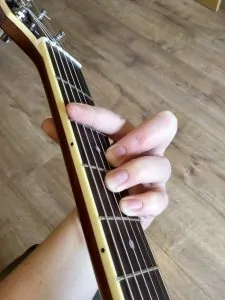
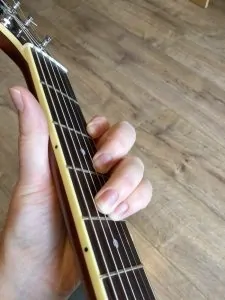

For an easier stretch, try playing your Bm barre chord (top left) as a four-string variation (top middle), a power chord (top right) or as a triad (bottom left and right). Just remember to mute any strings you aren’t fretting.
Still having trouble? You can also substitute your barre chords for triads. These chords are based on the barre shape, but only include three strings at a time.
Like the four string variation, triads don’t capture the full tonality of a full barre chord. But they add a bright, pleasant tone to your playing.
Raise it an octave
As I mentioned before, the neck of your guitar gets progressively thinner as you move toward the bridge. One option to get away from open chords by the nut is to play them an octave higher.
Just pretend that your 12 fret is your nut and mute any open strings from your standard chord positions. Especially with a cutaway, it’s much easier to play your basic chords from here.

Compare the stretch needed when playing a G7 chord at the 3rd fret (left) vs. the 15th fret (right) of the 6th string.
This method works just as well for individual notes too.
Altering Your Notes
Now that you’ve experimented with different finger exercises, tunings and chords, you might be wondering what to do for lead techniques.
The good news is that any player with any sized hand can become a solid lead guitarist. You just need to find the right adjustments for your small hands.
Play a different string
Once you familiarize yourself with your fretboard, you may find it easier to play the same note (or unison) in a different position.
Let’s say you’re playing a walk-up on your 5th string (A) from the 2nd to 5th fret. Or, in other words, from a B to a D. If you can’t reach the 5th fret with your pinky, you could try playing your open 4th string instead, which is also a D.
If you don’t mind raising or lowering the pitch, you could also use your octave shapes to find other notes that are easier to play.
It takes some time to master this technique. But by memorizing your notes across your strings and frets, you’ll save your fingers from extreme stretches.
Try tapping
Tapping is pretty niche and definitely not for everyone. But if you’re an electric guitarist who loves 80s metal or Stanley Jordan jazz, then it’s a great technique to add to your repertoire.
By playing a string with two hands instead of one, you can create fast, complex rhythms that span several frets. All without cramping your left hand.
<iframe width=”560″ height=”315″ src=”https://www.youtube.com/embed/8rFXwq97IhA” frameborder=”0″ allow=”accelerometer; autoplay; clipboard-write; encrypted-media; gyroscope; picture-in-picture” allowfullscreen></iframe>
Check out this video for an introduction to tapping.
Final Thoughts
At first glance, it may seem like having huge hands is a prerequisite to becoming a great guitar player. While modern instruments and teaching styles tend to cater to big-handed musicians, there’s no reason why you can’t succeed with small hands.
After all, Angus Young, Prince and St Vincent have only small- to average-sized hands. Even more impressively, Django Reinhardt and Jerry Garcia have adapted their playing without the use of all of their fingers!
Once you’ve chosen the guitar that feels right for you, scheduled some finger stretching into your practice sessions and experimented with different tunings, chord voicings and lead techniques, you’ll discover that playing guitar isn’t impossible as it once seems.
And before you know it, all those tricky chord progressions and walk-up solos will be a piece of cake.

